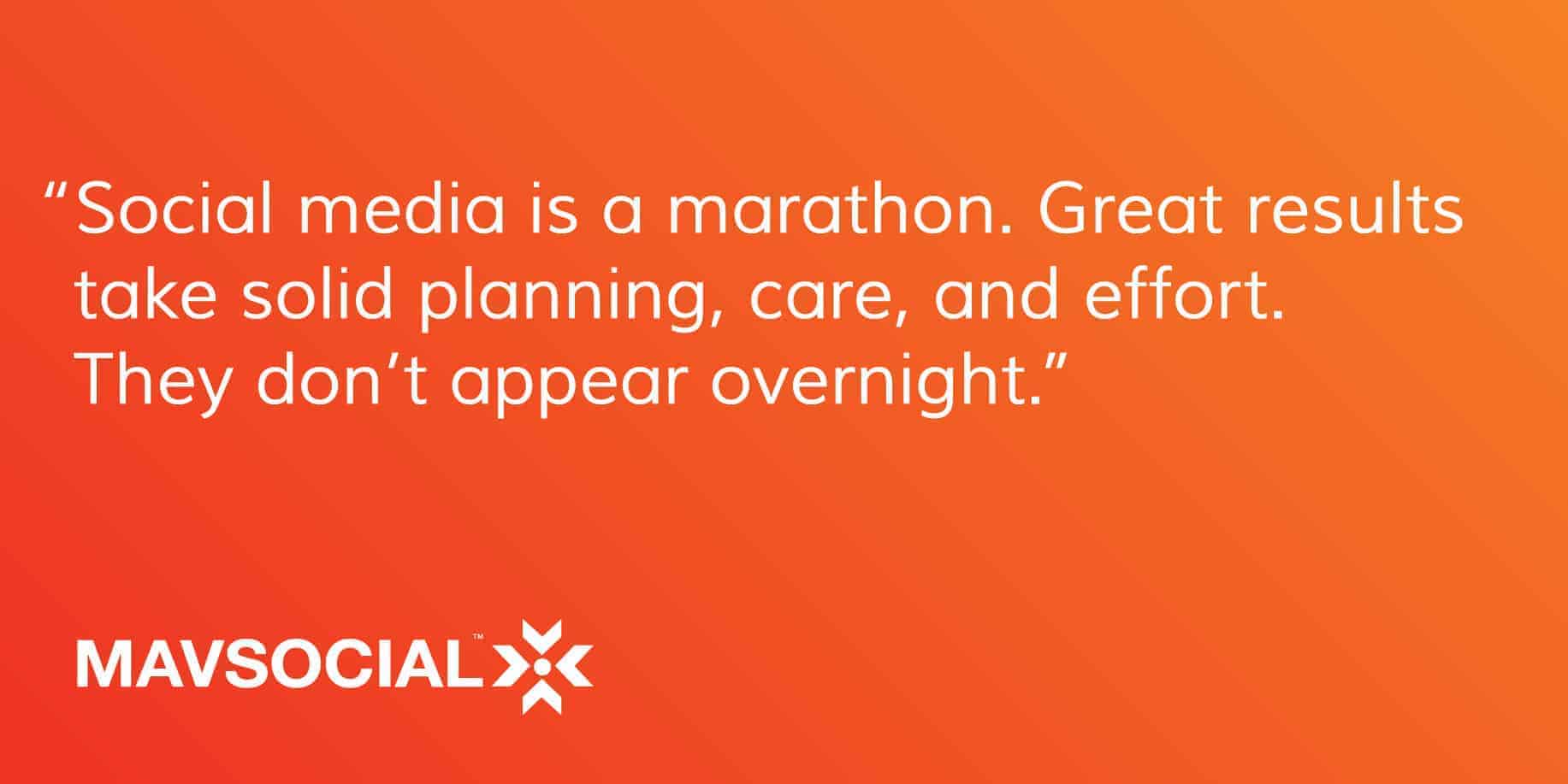You should be on social media. That’s what all the experts say, right?
If you are not, your business will become irrelevant. A relic. Nobody wants that.
So, you studied the articles, poured over consumer statistics and made the leap. You put your business on the social media map and waited for the results you were promised.
Nothing happened.
You are not alone—59% of small businesses fail to see any ROI from their social media efforts.
Instead of shares and fascinating conversations, there’s deafening silence across your accounts. No engagement. Nothing stirs.
Popular platforms like Facebook, Twitter and Instagram are littered with largely inactive profiles from businesses that jumped in but failed to see the kind of return on investment they expected.
Yet a quick google search of “social media for small business” returns almost 70 million results, a huge percentage of which point out the importance and benefits of an active social media presence.
Consumers want to connect with you
According to a study of consumer habits conducted by Vistaprint, 60% of consumers said that it was important for a small business to have a social media presence. Today’s consumer wants to connect with interesting brands online because it makes them seem more real. We don’t really trust businesses that don’t have a website—everyone is online, even grandma.
So why aren’t you seeing any return on investment from social media and what can you do to change that?
1. You don’t have a clear strategy
Wading into social media without set goals is a bit like driving through an unfamiliar area at night and expecting to end up at your destination by magic. Yes, you might get lucky once or twice but, most of the time, you’ll end up stuck frustratingly far from where you want to be.
To be successful on social media you must have a clear, tangible goal in mind.
What do you hope to achieve? Do you want to get people interacting with your brand? Do you want to send them to a particular landing page? Make them aware of a special promotion? Get testimonials?
Decide on your goal, write it down and break it up into smaller chunks. This is what you are going to base the rest of your strategy around. So, if your overarching goal is to increase brand recognition on Twitter, you can break it down into measurable parts like clicks, favorite and retweets.
A clear, measurable goal gives you a framework around which to build your posts and create engagement.
2. There’s no integration between your various channels
Every social media platform has its own best practices, audience and language. Reposting the same content across all your platforms is not only annoying, it’s ineffective.
Would you use the same language and style teaching a group of six-year-olds and a group of amateur bakers how to make a chocolate cake? The same principle applies to social media.
To get a return on the time and money you spend on social media, you have to pay attention to what the users of that platform are looking for. Speak their language. A tweet is different from a facebook post because we look for different things on Twitter and Facebook.
Every social media profile is a distinct piece of your overall content marketing plan. Keep them unique and targeted and you’ll see a growth in engagement.
3. You are going too big, too fast, and expecting too much
There are a finite amount of hours that can be dedicated to social media every week. If you try to do too much, too quickly you are on your way to burnout and sub-standard results.
Initial growth and engagement on social media can be maddeningly slow. Great results take solid planning, care and effort. They don’t appear overnight.
To see real change, focus on building your accounts one step at a time. Find out where your customers are then pick the platform you like working with the most and produce regular, quality content for it.
Social media is a marathon. It’s a long-term commitment and to really see great results you have to enjoy what you are doing (at least most of the time.)
4. You are hard-selling too much
Social media is not where you hard-sell your products and services. It can feel a bit counterintuitive because the reason you are there is to promote your business.
The key here is to promote, not sell. Social is where you build and strengthen customer relationships. It’s an opportunity to listen, connect and build trust- and all these greatly influence future purchasing decisions. Follow the 80/20 rule—80% of what you write shouldn’t be about you.
No one likes to be sold to while they are relaxing. What we do like are brands that listen to us, care and make us laugh. It’s a lot like a first date. Nobody likes the person that spends the entire date talking about themselves then asks you to pick up the check.
Be the person that cares. Share interesting articles that your audience will love. Tell them about deals complementary brands have going on. If you sell melted chocolate tell them about the stand that has half price strawberries.
Here’s an example of good social media management by Kellogg’s, they are retweeting user-generated content, talking about the international events and also promoting their products in a creative manner to engage effectively with their followers.
? #fruitycheerios for #breakfast this morning! Y’all have to try @KelloggsUS pic.twitter.com/AyTopceBMu
— Tamara Nichele11♏️11 (@Tscorp1111) September 3, 2016
Build your reputation as a business that cares. A great reputation leads to sales down the road.
5. You aren’t listening or taking part in existing conversations
LinkedIn Groups. Twitter Chats. Facebook Pages. That’s where the conversation happens. Be where your audience is and engage them on their own ground first, somewhere where they feel comfortable.
Use tools like Mention and Google Alerts to keep up with what’s important to your customers and use social media to show them how you can solve their problems.
6. Your content is boring
There’s this thing a lot of people do. When we are unsure or a little scared of something, we panic and don’t show any personality whatsoever. We fall into the trap of business speak because it can be strangely comforting in an unfamiliar situation.
That’s not what people are on social media for. We look for engaging, fun stuff to take our mind off the seriousness of life for a little while.
The 2015 Nielsen Global Trust In Advertising Study found that 50% of the North American audience loves ads that rely on humor. Our expectations of non-ad content are even higher.
People want to engage with you, not a robot version of you. Have fun with your updates—share memes, pics and stories that are interesting as well as relevant to your brand.
Make someone laugh and you are forging a positive connection. Laughter releases endorphins that create a bond between you. It makes you memorable and increases trust.
As long as you stay true to your brand, embracing your personality can go a long way to increasing social media engagement and generate leads.
Reap the rewards of your investment
To see a real, measurable return on your investment, create a goal based integrated strategy that shows a little personality, consistently creates value for your target audience and doesn’t stretch your resources too thin.
Social media is a long-term play. It’s about creating and harnessing trust and trust takes time to build with any audience.
That’s why you need to show them that you are willing to show up regularly, engage authentically and listen to what they care about.


